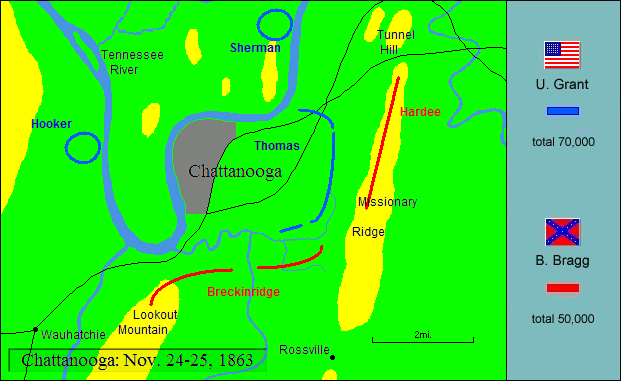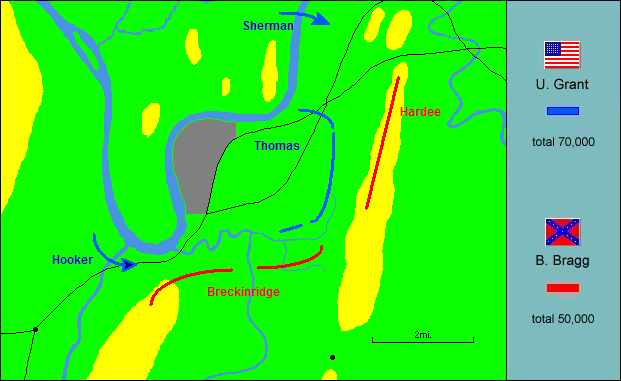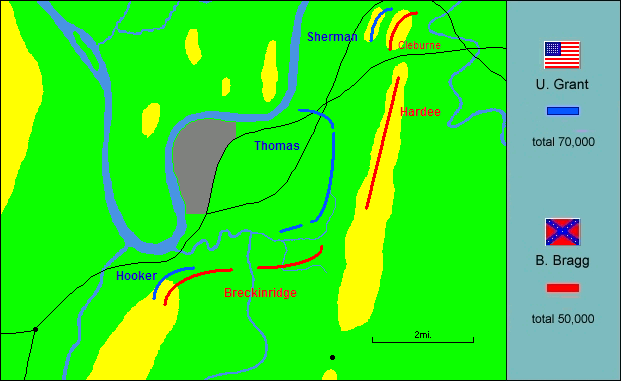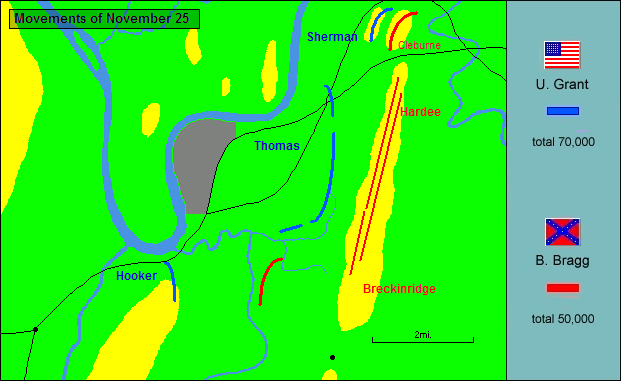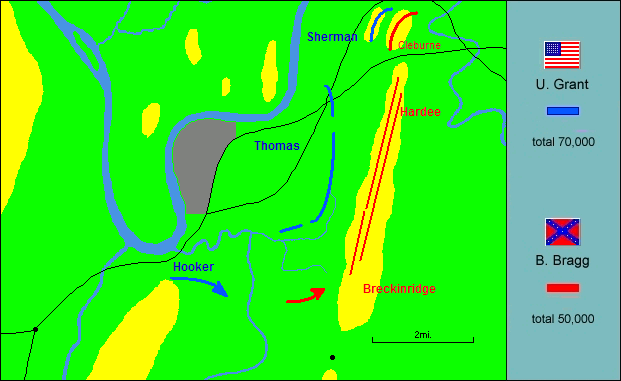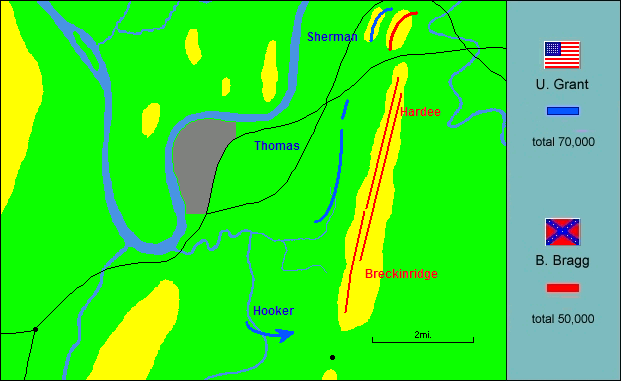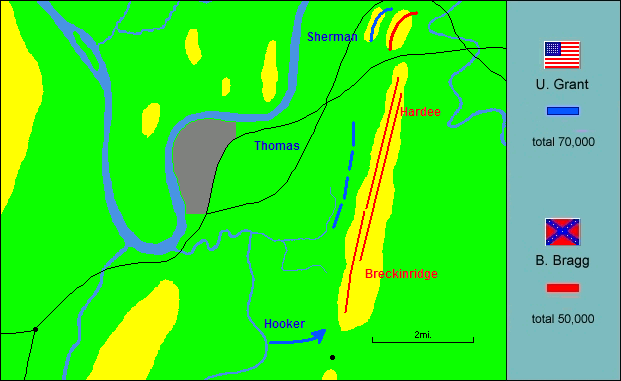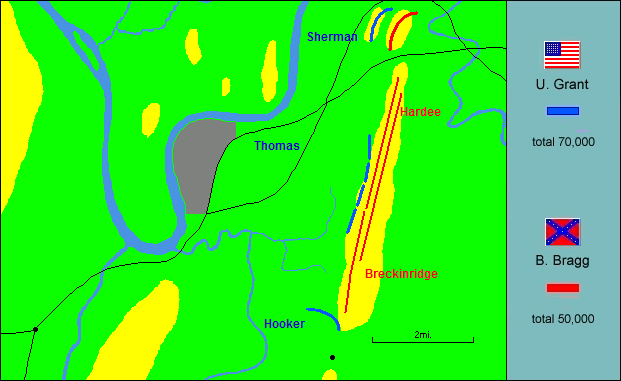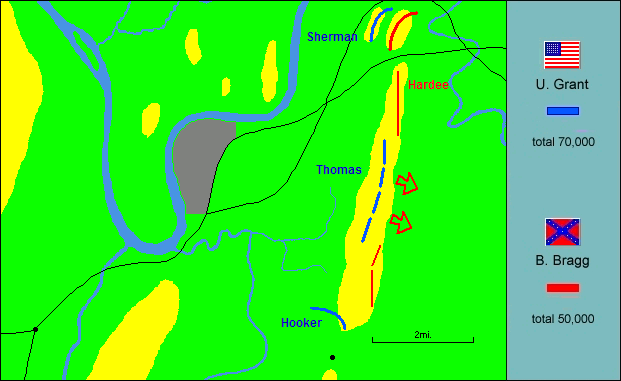When those fellows get started, all hell can’t stop them.
–Gordon Granger, of the assault on Missionary Ridge
When Jeff Davis was sure that the moment of crisis had come in the West, his first impulse was to turn to his most trusted commander, Robert E. Lee. Lee of course had declined to leave Virginia, and Longstreet had gone west in his stead. Now Lincoln turned to the man he couldn’t spare, Ulysses S. Grant. Grant in fact had not done much since Vicksburg. Halleck, still convinced that the way to win the war was to occupy Southern territory, had scattered pieces of Grant’s Vicksburg army all over the West. Now Lincoln called Grant to command a new military district, the Department of the Mississippi, stretching from the crest of the Appalachians to the banks of the Mississippi River, “with his headquarters in the field.” Grant arrived in Chattanooga on October 23 and went to work with a will. First, he replaced Rosecrans with the redoubtable Thomas. William T. Sherman was already on his way with 17,000 men in four divisions from Vicksburg to help lift the siege. From the east two corps under Joe Hooker, the XI and XII, were coming by rail from the Army of the Potomac. In an extraordinary demonstration of the North’s industrial strength and logistical skill, 20,000 men with all their impedimenta made a journey of more than 1,200 miles in eleven days. The beleaguered bluecoats began to feel that a mover and a shaker was at hand in the person of that slight, stoop-shouldered general. On the night of October 28-29, Grant sent a force downstream to pry the Confederates loose from Brown’s Ferry. Grant, it seemed, could do no wrong. In the fighting there the hapless XI Corps, so recently routed at Chancellorsville and Gettysburg, distinguished itself. Before October was out, Grant had opened a “cracker line” over the Tennessee, through a gap in Raccoon Mountain, and 60 miles west to the Federal railhead at Bridgeport. Now, Lincoln said, the army could once more “board at home.”
By the first part of November, Grant had more than 70,000 men in Chattanooga and hardtack, coffee, and cartridges coming in for them from the west. He was resolved now to break the siege. It looked as though he would need every musket because the positions the Confederates held were naturally formidable. To the south was two-thousand-foot Lookout Mountain, with Rebel guns mounted on its top; to the east was the six-mile crest of wooded Missionary Ridge defended by three successive lines of trenches. As far as Grant was concerned, a frontal assault against the ridge was doomed to bloody failure. But if Thomas and the Army of the Cumberland could hold its center, Sherman with his two corps from the Army of the Tennessee could strike from the north while Hooker’s two corps from the Potomac could strike from the south. Although Grant expected the real effort to be made by Sherman, his old Shiloh comrade, Thomas moved first. On November 23 Thomas advanced to Orchard Knob, high ground directly opposite Missionary Ridge, which would serve as a staging area for the demonstration he expected to make later. The next day Grant struck on both flanks. To the north Sherman’s attack jumped off smartly, achieving its first objective–the northern end of Missionary Ridge–easily. But as it turned out, that north slope was an isolated spur separated from the ridge by a rocky ravine. On the far side of that ravine was Pat Cleburne’s hard-fighting division, and Sherman’s attack stalled for the day.
On Lookout Mountain, Joe Hooker was enjoying better luck, however, and a rich opportunity to restore the reputation tarnished at Chancellorsville. The mountain was of course good ground to defend, but Bragg had too few there to defend it. Hooker sent nearly three full divisions against three thin Rebel brigades–a six-to-one edge. In a dramatic scrambling uphill fight, Hooker’s men drove the Rebels from position after position on the north face and finally down the other side toward Missionary Ridge. Late in the day a heavy mist enveloped the mountain, and after the war those with a romantic turn of mind remembered the fight as “The Battle Above the Clouds.” As it happened, it was a good day’s work for Joe Hooker’s boys. They had broken Bragg’s grip on the left at a cost of just 500 casualties. That night, as the mist rolled away, the fighting men witnessed a total eclipse of the moon. Literary Southerners might have recalled that in Shakespeare the death of Caesar was preceded by precisely the same omen: the moon was “sick almost to doomsday with eclipse.” The next morning, November 25, a Federal outfit from Kentucky raised the stars and stripes on Lookout Mountain’s summit.
While the Kentucky boys were climbing the mountain with the colors, Grant renewed his attack on Missionary Ridge. Again, Thomas would hold the center, Hooker would press from the south as soon as he got in position, and the main effort would be Sherman’s from the north. Sherman’s men crossed the ravine at daylight and charged up the slope. There they got all they bargained for and more. For eight hours Cleburne’s men kept up a galling fire that stopped Sherman’s attack in its tracks. When the Rebel gunners discovered that they could not sufficiently depress their muzzles to shoot down on the bluecoats, they lit the fuses of their shells and either hurled or rolled them downhill on their attackers. At one point they came boiling out of a railroad tunnel on their left and struck Sherman a stinging counterattack. In short, by 3:00 Sherman had made no progress on Bragg’s right, and Hooker had yet to get a bridge over a stream that barred his way to Bragg’s left. Grant had to do something to support Sherman, and if it couldn’t be done by Hooker, then it must be done by Pap Thomas and the Army of the Cumberland. Grant, for reasons known best to Grant alone, nourished a mistrust of George Thomas, despite his outstanding combat record, which included his unflinching stand at Chickamauga. Thomas was certainly a deliberate fighter, and it may be that he moved too slowly to suit his new commander. Then, too, Grant mistrusted the Cumberland men, for they had been swept from the Chickamauga field in rout back in September. Still, about the time Sherman’s attack had stalled in front of Cleburne, Grant ordered Thomas to attack the first line of trenches at the foot of Missionary Ridge. The Cumberland men might not take the position, but the assault would at least prevent Bragg from reinforcing his right.
Thomas would make his attack with four divisions, 23,000 men, over open ground on a two-mile front against an enemy well-entrenched and supported by guns on the crest. However unpromising the prospects, the men were in fact eager to attack, still smarting as they were from the Chickamauga rout as well as insults real or imagined from their comrades with Hooker and Sherman. At 3:30 the attack jumped off, and almost before they knew it, they drove the Rebels out of the first line at the foot of the ridge and sent them scrabbling up the slope to the second line halfway up. Having gained success in so swift a rush, the attackers now found themselves in an awkward fix. They had gained the first line of trenches, it was true, but with a stinging fire coming down from the two lines up the slope, they could hardly stay where they were. Even so, they were under no orders either to advance or withdraw. Then came an inexplicable, electric spark generated by who knows what–anger, revenge, pride, perhaps nothing more than coursing adrenalin. It may be that the presence of combative Phil Sheridan was one flashpoint. He’d been studying the work of a Rebel battery on the crest. Pulling a flask from his pocket, he raised a toast to them, to which the gunners responded by sending a shell his way. “That was ungenerous!” fumed Little Phil. “I’ll take your guns for that!”
In any event, without word of command the men in ranks started surging up the face of Missionary Ridge. “At times their movements were in shape like the flight of migratory birds,” a Federal officer remembered, “sometimes in line, sometimes in mass, mostly in V-shaped groups, with the points toward the enemy. At these points regimental flags were flying, sometimes dropping as the bearers were shot, but never reaching the ground, for other brave hands were there to seize them. Sixty flags were advancing up the hill.” Among the color bearers was an eighteen-year-old Wisconsin soldier, Arthur MacArthur, Jr., who would win a Medal of Honor for this valiant day and live to hand down his combative nature to his son Douglas. Watching from his headquarters on Orchard Knob, Grant was none too pleased to see more than 20,000 men scrabbling and scrambling up that ridge. He had given no such orders and wanted to know who did. Gordon Granger was at hand, and he knew something about soldiers willing to act on their own hook. At Chickamauga he had taken his division to Thomas’ support on his own initiative and fought steadfastly with him until dark. To Grant, Granger simply answered: “They started up without orders. When those fellows get started, all hell can’t stop them.”
Certainly, on this November day Braxton Bragg’s Army of Tennessee could not stop them. On they came shouting “Chickamauga! Chickamauga!” As so often in Bragg’s hard luck army, nothing went right despite the natural strength of the position. First, there was confusion at the base of the hill. There some units understood that they were to fire two volleys before withdrawing up the hill; others understood they were simply to withdraw. To those under orders to remain, the retreat of their comrades was unnerving and they, too, broke in panic–and nothing is so swiftly communicable as panic. Then, too, the Yankees were so hard on the heels of fleeing Confederates that Rebels in the second line had to hold their fire as fugitives and attackers came climbing up nearly together. Nor had Bragg’s engineers, despite two months to do the job, laid out the best possible line on the heights. It was too far back on the ridge, on the crest proper, and in many places on the slope the ground afforded cover to the attackers. Finally, though, it may be that, after months of defeat, desertion, and dissension, Bragg’s army was already beaten. In any case, relentlessly on the Yankees came, and then, as a Tennessee Rebel remembered, the Confederates just threw down their guns and broke to the rear like quarter horses. The same witness saw Bragg on the crest, cursing and trying to rally his men. “Here is your commander,” Bragg shouted. “Here is your mule,” they shouted back. Four thousand Rebels surrendered and the rest ran. “My God,” one astonished Yankee called out, “come and see ’em run.”
For Bragg there was nothing to be done but take his beaten army into Georgia, characteristically blaming them for their defeat. Even Jefferson Davis was now prepared to admit that Braxton Bragg was not likely to lead them to victory. Soon after Missionary Ridge Davis bit the bullet and called Joe Johnston to command. At Knoxville, on November 29 Longstreet’s two divisions attacked a force twice their size and received a bloody check. Soon after, they were sent east, having enjoyed one brief smash-up success at Chickamauga that had come to nothing. Back in Virginia Robert E. Lee’s understrength army likewise could accomplish nothing. In November Lee and Meade clashed indecisively along the line of the Rapidan and eventually went into camp on opposite banks. In a sense, the fateful summer of 1863 came to a close on the crest of Missionary Ridge in November. The fall of Vicksburg in July had sundered the halves of the Confederacy forever, and after Gettysburg Lee would never again take his army over the Potomac. Now with Grant’s victory at Missionary Ridge, Chattanooga was secure to serve as the forward base of the Federal drive down the road to Atlanta. Southern power was in truth in eclipse, and thoughtful Southerners could see it. In Charleston, Mary Chesnut confided to her diary: “gloom and despondency hang like a pall everywhere.” The war that was wrecking and remaking American society was also bringing a new kind of warrior to the front of the Federal cause–relentless, driving, total-war men. Chief among them were high-strung, sandy-haired William Tecumseh Sherman and silent, cigar-smoking Ulysses S. Grant. When spring came again Sherman would have top command in the West and Grant would be general-in-chief of all the armies of the Republic, intent on the destruction of Robert E. Lee’s army in the East.
But as November of 1863 drew to a close, there remained the business of carrying off the wounded and burying the dead of Missionary Ridge. George Thomas ordered a cemetery laid out on Orchard Knob. Asked if the dead should be buried by states, Thomas answered, “No, no, mix ’em up. I’m tired of States’ Rights.” But Union men and States’ Rights’ men had many more bloody roads to march before the nation settled the question of the sovereignty of states and the rights of man.

